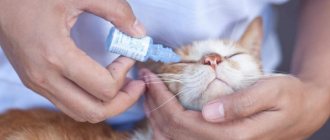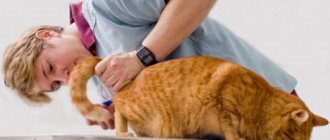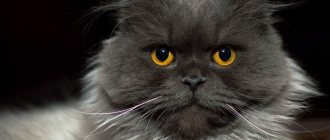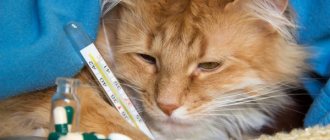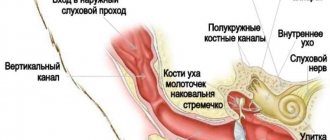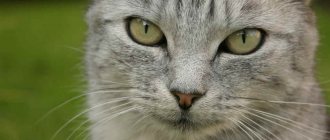Hello everyone!
“First aid” for our own “harmless” runny nose is droplets. And you can run to work. But when our eyes water and fester... We don’t run anywhere - we sit at home and get treated properly.
If our beloved pet—the cat’s eyes and nose are running—our concern has every reason: after all, any illness, if left untreated, becomes dangerous. Including the “banal” cold, which cats supposedly don’t get. They're sick! Yes, less often than us, but like us, due to hypothermia, drafts, cold food and low immunity.
So why does this happen and what should we do? That is the question!
Types of conjunctivitis
- Bacterial conjunctivitis - sequentially affects both eyes: first one, and after 1-3 days - the second. May be complicated by keratoconjunctivitis, blepharitis. Includes several subspecies:
- Gonorrheal conjunctivitis, or gonoblennorrhea of newborns. Appears on days 2-3 of life.
- Chlamydial - appears on days 5-10 of life. In older children, infection is possible in closed reservoirs and swimming pools.
- Diphtheria - usually develops with diphtheria of the pharynx, most often affecting children under the age of 4 years. Thanks to vaccination, there are only isolated outbreaks of morbidity. Source: N.N. Arestova, L.A. Katargina, E.V. Yani Conjunctivitis and dacryocystitis in children: clinical characteristics, modern treatment options // Russian Pediatric Ophthalmology, 2016, No. 11(4), pp. 200-206
- Viral conjunctivitis usually develops against the background of acute respiratory viral infection. They may be complicated by a secondary bacterial infection, which causes purulent discharge from the eyes.
- Herpetic conjunctivitis is characterized by rashes, in the place of which, after opening, scars remain.
- Allergic – inflammation of the mucous membrane of the eyes due to a reaction to any substances, hair and particles of animal epidermis, medications, dust. It can occur in acute and chronic form and is complicated by bacterial infection.
Nasal discharge.
They, as protection against dust and germs, are normally always present during washing.
If they become abundant, then the cause may range from simple irritation to problems with parasites, fungi, tumors, but if the kitty is still sneezing and breathing heavily, it means it is already seriously ill.
In the case of yellow or green snot, purulent and serous discharge with the formation of crusts, also the presence of blood in them, swelling of the muzzle - the diagnosis can be no less terrible! All infections develop very quickly and require immediate medical attention!
For example, for rhinitis - inflammation in the nasal passages, in which the protective secretion is produced especially strongly, experts prescribe:
- various types of warm nasal rinses (the simplest: 1 teaspoon of salt in 1 liter of water, boil for 2 minutes, strain) using a convenient insulin syringe without a needle: pour 0.5 ml into the nostril, and as soon as the cat snorts and sneezes, the passage will become free, then you can wash the second passage;
- warming with a warm bag of salt or sand (not possible if the mucus is yellow or green!);
- treatment with sea buckthorn oil and oxolinic ointment;
- instillation of naphthyzine for children;
- antibiotics.
When hit by a small particle or insect, the animal sneezes and is usually released in this way. And if he doesn’t succeed, then you can first try to carefully remove the speck yourself with tweezers. Sometimes mucus comes out of a damaged nostril along with blood. Then contact your veterinarian, because in difficult cases you will need an x-ray and even extraction under anesthesia.
Cancer in the nasal cavity has many symptoms, including discharge, sneezing, loss of appetite, lethargy, bleeding and foul odor. The success of treatment depends on the stage and takes place in the hospital.
Reasons for the appearance of a child
The inflammatory process on the conjunctiva can be provoked by:
- Viruses, including adenovirus and herpes. The disease lasts no more than 10 days, but can be complicated by bacterial infection.
- Infections – gonococci, streptococci, Pseudomonas aeruginosa, staphylococcus, fungi. The disease is severe, on average 2 weeks.
- A fungus that affects children with immunodeficiency.
- Chlamydia is an intermediate microorganism between viruses and bacteria.
- Improper hygiene, eye injuries with subsequent infection.
- Allergy – intolerance to certain substances, medications, products.
- Long-term inflammatory diseases of the nose, eyes, ears - tonsillitis, sinusitis, rhinitis.
1.General information
The diagnosis of “ozena” (fetid runny nose) implies not only the unpleasant odor of nasal discharge. The key, syndrome-forming point is the presence of a chronic progressive atrophic process in the mucosa involving the deeper bone tissues of the nose.
Currently, ozenous runny nose is apparently much less common than in ancient times; on the other hand, this can be explained by the fact that at the dawn of medicine, any disease accompanied by foul-smelling nasal discharge (leprosy, syphilis, tuberculosis, etc.) was classified as ozena. The frequency of occurrence of true, genuine ozena is estimated today in hundredths of the total volume of registered ENT pathology. Various studies have noted certain regional, ethnic, and gender dependencies.
Children and young people are more likely to get sick; Women predominate among those affected.
A must read! Help with treatment and hospitalization!
Signs of conjunctivitis in children
Symptoms vary depending on the type of disease. However, there are general signs characteristic of any inflammation of the conjunctiva:
- swelling of the eyelids;
- swelling of the conjunctiva;
- fear of light;
- increased lacrimation;
- Pain in the eyes;
- sensation of a foreign body in the eyes;
- blepharospasm.
In infants, the disease can be suspected by frequent crying, restlessness, and frequent attempts to rub their eyes.
Signs of diseases, depending on the type:
- Bacterial has a typical symptom in the form of viscous or mucopurulent discharge from the eyes. The child's eyelids stick together and crusts dry out on the eyelashes. The color of the pus can be light yellow or even yellow-green.
- Gonorrheal is characterized by bluish-purple skin color, dense swelling of the eyelids, swelling of the conjunctiva, and copious discharge of pus.
- Chlamydial - swelling of the mucous membrane of the eyelids, drooping eyelids, liquid pus in the conjunctival cavity.
- Diphtheria - thickening of the eyelids, painful swelling, discharge of cloudy secretions, gray films on the surface of the conjunctiva, after removal of which the mucous membrane bleeds.
- Viral - copious watery discharge plus symptoms of ARVI.
- Herpetic - blistering rashes on the eyes.
- Allergic – excessive lacrimation, redness and swelling of the eyes.
Tumors and polyps in the upper respiratory tract
Neoplasms are one of the possible reasons why a cat sneezes with snot and watery eyes. Tumors usually occur in pets older than 7 years, but age is not an indicator of health. A runny nose in such situations is accompanied by blood or clots, the cat intensively rubs its eyes with its paws and sneezes.
From the entire appearance of the animal, it seems that something is in the way and causing discomfort. Due to tumors, the animal's face becomes swollen and deformed.
© shutterstock
Diagnostic methods
Before treating conjunctivitis, it is necessary to identify what type of conjunctivitis is present in the child. To do this, first a history of the disease is collected, and then laboratory and ophthalmological examinations are prescribed:
- biomicroscopy of the eye;
- a smear from the conjunctiva followed by cytological examination in the laboratory;
- analysis for the level of IgE and eosinophils in the blood;
- skin allergy tests;
- tests for worms and dysbacteriosis;
- microscopic examination of tear fluid;
- bacteriological examination of discharged pus;
- scraping for enterobiasis.
If an allergic type of disease is suspected, the child is advised to consult an allergist, who will prescribe additional tests.
Breed predisposition
As a rule, breeds with flattened, short muzzles (brachycephalics) cry most often over bowls due to the structural features of the skull. Similar problems can also occur in representatives of long-haired breeds (obstruction of the tear ducts).
Thus, tearfulness is noted in Persians and their crosses, British and Scottish cats, Sphynx cats and their crosses. For example, the British have blocked tear ducts, but if the cat feels well, there is no reason to worry.
How to cure conjunctivitis in a child?
Treatment for conjunctivitis depends on the child's symptoms and type of disease.
For the bacterial form of the disease, antibiotics in the form of eye ointments or drops are indicated. Every 2-3 hours, to prevent the formation of a purulent crust, the eyes should be washed with special solutions. It is better to instill drops during the day, and apply ointment to the eyes at night, because it relieves itching, pain, helps you sleep and prevents eyelids from sticking together.
In case of allergic conjunctivitis, first of all, you need to protect the child from the allergen. Antihistamine and anti-allergenic drops are prescribed. The course of treatment is usually 2-4 weeks. Source: L.D. Ksenzova Treatment of allergic conjunctivitis in children // Issues of modern pediatrics, 2008, vol. 7, no. 5, pp. 135-140
Viral conjunctivitis does not require special therapy. Within a few days, the child’s body copes with it on its own. It is important during this period to prevent infection - maintain personal hygiene, do not scratch your eyes, and wash your face twice a day.
Why make your own decisions?
The consequence of the disease can be caused by various motives and, without making a conclusion about the correct diagnosis, the animal may be harmed.
List of contraindications:
- If a cat's eyes are festering and she is sneezing, then this is not a reason to give her antibiotics right away. If the disease occurs due to improper metabolism, then such drugs will only worsen its condition.
- Treatment for inflammation caused by bacteria should begin only after clarifying the circumstances: what specific harmful microorganisms have settled in the body.
- If a cat has a deficiency of vitamins, then medications will only have a negative effect on the body.
You should always start by diagnosing the animal's condition, and it is not easy after discovering when he is sneezing.
Disease prevention
Basic preventive measures:
- disinfect the room in which the child is located;
- observe the rules of personal hygiene;
- strengthen immunity;
- Avoid contact with anyone who has conjunctivitis.
Do not delay going to the doctor if you notice signs of this disease in your child. The earlier treatment is started, the lower the risk of complications. Make an appointment with a SM-Clinic specialist.
Sources:
- N.N. Arestova, L.A. Katargina, E.V. Yani. Conjunctivitis and dacryocystitis in children: clinical characteristics, modern treatment options // Russian Pediatric Ophthalmology, 2016, No. 11(4), pp. 200-206.
- L.D. Ksenzova. Treatment of allergic conjunctivitis in children // Issues of modern pediatrics, 2008, vol. 7, no. 5, pp. 135-140.
Ageev Vladimir Sergeevich Clinic
Author of the article
Ageev Vladimir Sergeevich
Candidate of Medical Sciences
Specialty: ophthalmologist
Experience: 16 years
The information in this article is provided for reference purposes and does not replace advice from a qualified professional. Don't self-medicate! At the first signs of illness, you should consult a doctor.
2. Reasons
The documented history of the study of ozena, confirmed by archaeological finds, goes back more than three and a half thousand years, but the etiopathogenesis remains unclear to this day. Among the many assumptions put forward and discussed, the following hypotheses dominate:
- infectious (in 80-90% of patients, a coccal, capsule-forming, antibiotic-resistant bacterial culture of the genus Klebsiella is sown, which was given the subspecies name Klebsiella pneumoniae ozaenae, i.e. Klebsiella pneumoniae ozaenae); However, the origin of ozena remains unclear in cases where Klebsiella is absent;
- genetic (features of the genome can explain, in particular, the endemicity and ethnic dependence of the incidence);
- endocrine (the predominance of women is explained, but other aspects do not fit into the dishormonal concept);
- neurodystrophic (according to which deep dystrophy and then atrophy are caused by disturbances in tissue nutrition and conductivity of the peripheral branches of the facial nerve);
- anatomical (the atrophic process is explained by anomalies or infantility in the structure of the paranasal sinuses and other nasal or paranasal structures);
- pathophysiological (ozena is considered as a complication or long-term consequence of frequent, acute, chronic inflammations - nasopharyngitis, laryngitis, etc.).
The main risk factors are hypovitaminosis, nasal injuries, diseases of the autonomic nervous system, smoking, industrial and environmental hazards.
Visit our Otolaryngology (ENT) page
Prices
| Name of service (price list incomplete) | Price |
| Appointment (examination, consultation) with an ophthalmologist, primary, therapeutic and diagnostic, outpatient | 1750 rub. |
| Consultation (interpretation) with analyzes from third parties | 2250 rub. |
| Prescription of treatment regimen (for up to 1 month) | 1800 rub. |
| Prescription of treatment regimen (for a period of 1 month) | 2700 rub. |
| Consultation with a candidate of medical sciences | 2500 rub. |
| Biomicroscopy of the anterior segment of the eye | 500 rub. |
| Selection of glasses with plain lenses | 600 rub. |
| Subconjunctival injection (1 eye) | 500 rub. |
| Removal of a foreign body from the conjunctiva, from the eyelids | 800 rub. |

